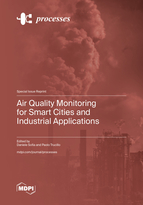Air Quality Monitoring for Smart Cities and Industrial Applications
A special issue of Processes (ISSN 2227-9717). This special issue belongs to the section "Environmental and Green Processes".
Deadline for manuscript submissions: closed (15 June 2023) | Viewed by 18170
Special Issue Editors
Interests: additive manufacturing; particle technology; air quality; laser sintering; powder technology; selective laser sintering; IoT development; nanomaterials
Special Issues, Collections and Topics in MDPI journals
Interests: liposomes; microparticles; targeted delivery; pharmaceuticals, stimuli induced delivery; process scale-up; process economic analysis; air quality monitoring; hydrometallurgy; platinum group metals; coatings
Special Issues, Collections and Topics in MDPI journals
Special Issue Information
Dear Colleagues,
Environmental pollution is one of the most relevant and discussed problems of modern times. in particular, air pollution has a great impact on the life of the planet, and air quality monitoring is a key aspect for reducing air-associated health diseases. One of the main themes of this issue is that of dealing with gaseous compounds leaving industrial production plants, which is often an expensive operation, due to the strict laws that governments have imposed.
Today, the importance of air quality is a topic in which it is extremely important to invest in terms of research activities. Indoor and outdoor quality monitoring systems are well accepted for contribution in this Special issue, together with critical reviews describing the problems in terms of pollution and their link with human health prevention. The topics of this Special Issue will include, for example:
- Treatment of gaseous waste from industry;
- Development of conventional and novel equipment for the monitoring of the main air quality parameters;
- Critical analysis of the outdoor air quality, industrial, motor vehicle and incinerator emissions, economic analysis;
- Indoor air quality in a working environment, in case of poor ventilation;
- Health impact of air pollution.
This issue is also open to health scientists proposing their studies on the effect of air pollutants on patient health, especially during this COVID-19 pandemic outbreak.
Dr. Daniele Sofia
Dr. Paolo Trucillo
Guest Editors
Manuscript Submission Information
Manuscripts should be submitted online at www.mdpi.com by registering and logging in to this website. Once you are registered, click here to go to the submission form. Manuscripts can be submitted until the deadline. All submissions that pass pre-check are peer-reviewed. Accepted papers will be published continuously in the journal (as soon as accepted) and will be listed together on the special issue website. Research articles, review articles as well as short communications are invited. For planned papers, a title and short abstract (about 100 words) can be sent to the Editorial Office for announcement on this website.
Submitted manuscripts should not have been published previously, nor be under consideration for publication elsewhere (except conference proceedings papers). All manuscripts are thoroughly refereed through a single-blind peer-review process. A guide for authors and other relevant information for submission of manuscripts is available on the Instructions for Authors page. Processes is an international peer-reviewed open access monthly journal published by MDPI.
Please visit the Instructions for Authors page before submitting a manuscript. The Article Processing Charge (APC) for publication in this open access journal is 2400 CHF (Swiss Francs). Submitted papers should be well formatted and use good English. Authors may use MDPI's English editing service prior to publication or during author revisions.
Keywords
- Air quality monitoring
- Detection of gaseous pollutants
- Novel pollutant tracking systems
- Sulfur dioxide
- Carbon monoxide and dioxide
- Nitrogen monoxide and dioxide
- Diseases caused by air pollutants
- Smart cities







